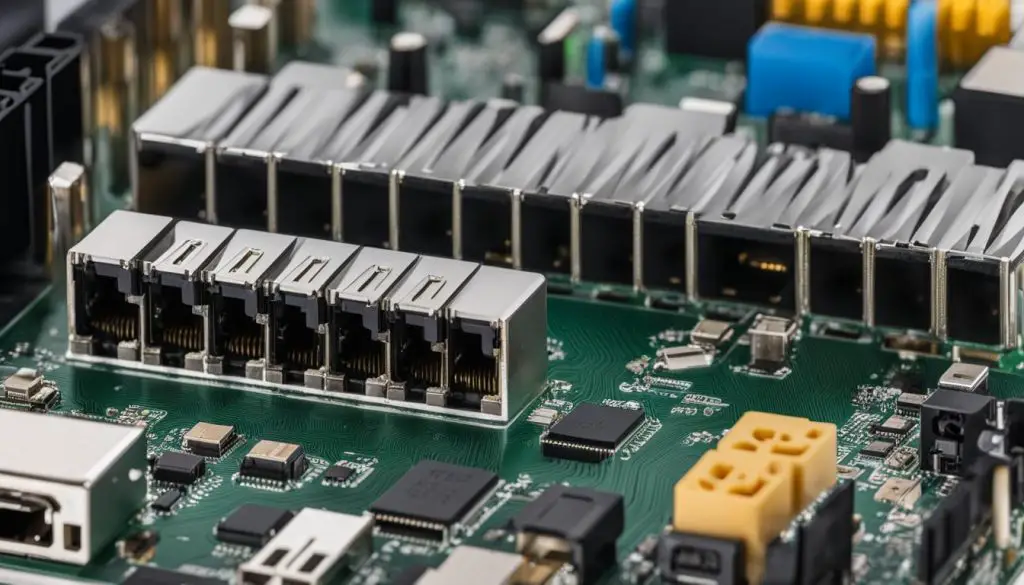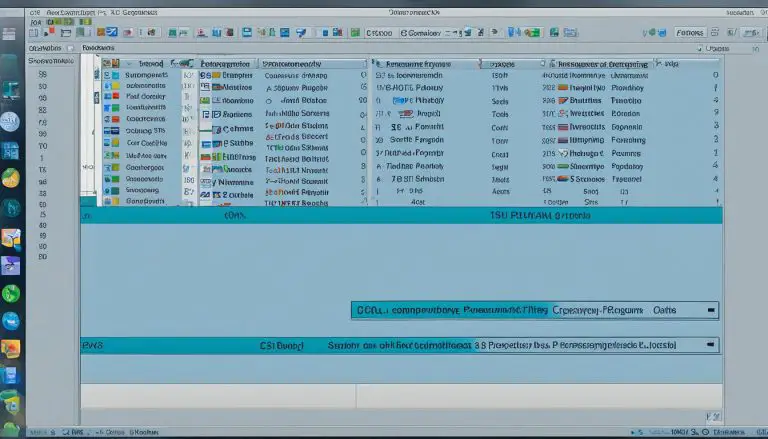Arch Linux vs Debian: A User’s Comparison Guide
In this comprehensive comparison guide, I will delve into the differences and similarities between Arch Linux and Debian. I will analyze their performance, features, and user experiences to help you make an informed decision. Whether you’re a novice Linux user or an experienced system administrator, this guide will provide valuable insights into these two popular Linux distributions.
Key Takeaways:
- Arch Linux and Debian are two popular Linux distributions with distinct characteristics.
- Arch Linux emphasizes customization and simplicity, while Debian prioritizes stability and security.
- Arch Linux follows a rolling-release model, providing users with access to bleeding-edge software updates.
- Debian has a conservative release cycle and extensive software package support.
- The choice between Arch Linux and Debian depends on your individual needs, technical expertise, and goals.
The Linux Landscape and the Prominence of Debian and Arch Linux
Before delving into the specifics of Arch Linux and Debian, it’s crucial to understand the larger Linux landscape and the prominence of these two distributions. Linux is an extensively utilized operating system, powering over 96% of the world’s top 1 million servers. Within the Linux ecosystem, Debian and Arch Linux stand out as prominent distributions, each with their own legacies and strengths.
Debian, known for its stability and community-driven development, has been a trusted choice for users since its inception in 1993. It boasts a vast number of packages and offers extensive hardware support. On the other hand, Arch Linux is renowned for its customization options and simplicity. It embraces a rolling-release model, ensuring users have access to the latest software updates.
To visualize the significance of Linux and the prominence of Debian and Arch Linux, consider the following statistics:
| Linux | Debian | Arch Linux | |
|---|---|---|---|
| Operating System | 96% of top 1 million servers | One of the most widely-used Linux distributions | Highly regarded for customization and simplicity |
| Server Usage | Overwhelming presence in the server market | Common choice for server administrators | Prevalent among advanced users |
| Open-Source Community | Thriving ecosystem of developers and enthusiasts | Strong community support and contribution | Active community fostering innovation |
As demonstrated by these numbers, Linux, alongside Debian and Arch Linux, plays a vital role in the open-source community and offers diverse solutions to meet the needs of different users.
In the next sections, we will explore the genesis and philosophy of Debian, delve into the unique features of Arch Linux, compare the advantages and disadvantages of both distributions, and analyze the characteristics that make them suitable for various audiences.
The Genesis and Philosophy of Debian
Debian, founded in 1993, has a rich history that spans nearly three decades. It emerged from the collaboration of Ian Murdock, a visionary computer scientist, and a group of like-minded developers. This open-source Linux distribution was born with a clear mission: to create a free and reliable operating system.
Debian’s philosophy revolves around a set of core values that have guided its development over the years. At the heart of its philosophy is a commitment to software freedom, promoting the use and distribution of open-source software. This dedication to freedom has fostered a vibrant community of developers and users, who contribute to the project’s growth and success.
Stability is another pillar of Debian’s philosophy. The distribution places a strong emphasis on providing a solid and dependable platform for users. Through rigorous quality control and thorough testing, Debian strives to deliver a stable operating system that users can rely on for their critical tasks and projects.
The security of the Debian system is of utmost importance. Debian developers work tirelessly to ensure that their software is secure and protected from vulnerabilities. Regular security updates and patches are released to address any potential threats, giving users peace of mind and confidence in the security of their systems.
Debian’s philosophy also extends to its role in the Linux ecosystem. It has played a significant part in the creation of popular distributions such as Ubuntu and Linux Mint. By providing a solid foundation and a wealth of software packages, Debian has empowered these derivatives to flourish and cater to a wide range of users.
In the next section, we will explore the foundation of Debian’s stability, digging deeper into the strategies and practices that make it a robust and reliable Linux distribution.
Arch Linux: A Paradigm of Customization and Simplicity
Arch Linux is renowned for its exceptional level of customization and simplicity that sets it apart from other Linux distributions. It offers users the freedom to tailor their operating system according to their specific needs and preferences, making it an ideal choice for those seeking a truly personalized computing experience.
The Rolling-Release Model of Arch Linux
One of the key features of Arch Linux is its rolling-release model. Unlike traditional fixed-release distributions, Arch Linux follows a continuous update cycle, ensuring that users have access to the latest software updates and security patches as soon as they become available. This model allows users to stay on the cutting edge of technology and benefit from the most up-to-date features and improvements.
The rolling-release approach also eliminates the need for major version upgrades, making the system maintenance process seamless and hassle-free. Users can enjoy a consistent and evolving experience without the disruption caused by frequent system reinstallation or migration.
Arch Linux’s Do-It-Yourself Ethos
Arch Linux embraces a do-it-yourself (DIY) ethos, empowering users to take full control over their operating system. With Arch Linux, users have the freedom to build their system from scratch, selecting and configuring components to suit their exact requirements. This level of control fosters a deep understanding of the system and allows for fine-grained customization.
By requiring users to actively participate in the installation and configuration process, Arch Linux encourages a hands-on approach to learning and understanding the intricacies of a Linux system. This ethos appeals to users who value the educational aspect of their computing experience and seek to develop their technical skills.
The Arch User Repository: A Treasure Trove of Software
The Arch User Repository (AUR) is a community-driven repository of user-contributed software packages for Arch Linux. It is an extensive and diverse collection of applications, libraries, and utilities, enriching the software ecosystem of Arch Linux. The AUR provides a platform for Arch Linux users to share, collaborate, and maintain software packages that are not available in the official repositories.
Users can easily access the AUR and install packages using specialized tools like yay or aura. This immense repository enhances the flexibility and versatility of Arch Linux, allowing users to install and customize their software stack to suit their specific needs, regardless of popularity or official support. The AUR truly embodies the community-driven spirit of Arch Linux.
| Feature | Arch Linux | Other Distributions |
|---|---|---|
| Customization | Highly customizable, allowing users to build their system from scratch | Limited customization options, with preconfigured setups |
| Rolling Release | Follows a rolling-release model, delivering continuous updates | Fixed-release model, requiring periodic major version upgrades |
| DIY Ethos | Encourages hands-on learning and configuration | Offers preconfigured setups for ease of use |
| Arch User Repository | Provides a vast collection of user-contributed software packages | Relies on official repositories with limited software availability |
Analyzing the Debian Ecosystem: Advantages and Disadvantages
The Debian ecosystem offers a range of advantages and disadvantages for users. It is known for its strong commitment to stability, extensive package management, and wide hardware support. However, Debian’s conservative release cycle and complex installation process can be potential drawbacks. In this section, we will analyze the Debian ecosystem in detail, exploring its advantages and disadvantages to help you evaluate whether it aligns with your needs and goals.
One of the significant advantages of the Debian ecosystem is its strong commitment to stability. Debian prioritizes rigorously testing software packages before including them in the official repositories, ensuring a reliable and stable operating system for users. This stability is particularly beneficial for server administrators and users who require a dependable and consistent platform.
Another advantage is Debian’s extensive package management system. Debian’s package repositories contain a vast collection of software, providing users with a wide range of options for their computing needs. The package manager, APT (Advanced Package Tool), simplifies the installation, upgrading, and removal of software, making it easy for users to manage their applications effectively.
Debian’s commitment to hardware support is another notable advantage. It offers excellent compatibility with various hardware architectures, ensuring that users can install and run Debian on a wide range of devices. This broad hardware support makes Debian a versatile choice for users with diverse computing setups.
However, there are also some disadvantages to consider within the Debian ecosystem. One potential drawback is its conservative release cycle. Debian’s stable release is known for prioritizing stability over the inclusion of the latest software updates. While this approach ensures a reliable and thoroughly tested system, it may lag behind in terms of having the most cutting-edge features or software versions.
Additionally, Debian’s complex installation process can be seen as a disadvantage for users seeking a more streamlined and user-friendly experience. The installation involves multiple steps and requires users to make various configuration choices. While this level of customization can be appealing to some advanced users, it may be overwhelming or time-consuming for those who prefer a simpler installation process.
Exploring the Arch Linux Advantage: Pros and Cons
Arch Linux offers unique advantages and disadvantages that set it apart from other distributions. In this section, we will delve into the pros and cons of choosing Arch Linux as your operating system.
Bleeding-Edge Software and the Rolling Release Benefits
One of the significant advantages of Arch Linux is its focus on bleeding-edge software. As a rolling-release distribution, Arch Linux provides users with access to the latest software updates and features as soon as they become available. This ensures that you are always at the forefront of technological advancements, enjoying the most up-to-date software.
The rolling-release model also eliminates the need for major system upgrades, unlike other distributions that follow a fixed release cycle. Instead, Arch Linux continuously updates its software, allowing for a smooth and seamless transition between versions. This eliminates the downtime associated with system upgrades and ensures a more streamlined user experience.
Customization at Its Peak with Arch Linux
Arch Linux is renowned for its unparalleled customization options. It follows a do-it-yourself (DIY) ethos, empowering users to have complete control over their operating system’s configuration and design. This level of customization is ideal for advanced users and enthusiasts who want to tailor their system to their specific needs and preferences.
Whether you want to customize your desktop environment, install specific software packages, or tweak system configurations, Arch Linux provides the flexibility to do so. The Arch User Repository (AUR) further enhances the customization capabilities by offering a vast collection of user-contributed software packages, enabling users to easily install and customize their software stack.
Arch Linux vs Debian: A Comparative Glance at Similarities
When comparing Arch Linux and Debian, it’s important to recognize the similarities they share despite their differences. Both distributions are open-source and based on the Linux kernel, which means they benefit from the collaborative efforts of the Linux community. These communities are known for their strong support networks and a willingness to help users overcome challenges and find reliable solutions. This sense of community fosters a welcoming environment for newcomers and experienced Linux users alike.
Furthermore, Arch Linux and Debian offer extensive software support through their package repositories. Users can find a wide range of software applications and tools to suit their needs and preferences, whether they are looking for productivity software, multimedia applications, or development tools. This versatility ensures that both distributions can cater to a diverse user base.
Overall, Arch Linux and Debian provide reliable, customizable, and secure Linux experiences. Choosing between them comes down to personal preferences, technical requirements, and the specific goals of the user.
| Similarities | Arch Linux | Debian |
|---|---|---|
| Open-Source | ✓ | ✓ |
| Based on the Linux kernel | ✓ | ✓ |
| Strong and supportive communities | ✓ | ✓ |
| Wide range of software support | ✓ | ✓ |
Key Differences: Arch Linux vs Debian
When comparing Arch Linux and Debian, several key differences become evident. These differences span across various aspects, including package management systems, system configuration and setup processes, and release cycle and update philosophies. Understanding these distinctions can help users make an informed choice between the two distributions.
Package Management Systems Compared
Arch Linux and Debian differ in their approaches to package management. Arch Linux utilizes a package manager called “Pacman,” which focuses on simplicity, speed, and minimalism. It follows a rolling-release model, which means that users receive frequent updates with the latest software versions.
On the other hand, Debian utilizes “APT” (Advanced Package Tool), a package management system known for its stability and dependency management. Debian follows a more conservative release cycle, favoring stability over the latest software updates.
It’s important to consider your preferences and requirements when choosing between Arch Linux’s dynamic and cutting-edge package management system or Debian’s stable and time-tested approach.
System Configuration and Setup
In terms of system configuration and setup, Arch Linux and Debian take different approaches. Arch Linux adopts a minimalistic and do-it-yourself ethos, allowing users to have complete control over the system configuration process. It provides a bare-bones installation with only essential components, enabling users to customize their system to their needs. This approach requires a higher level of technical expertise and a deeper understanding of the Linux operating system.
On the other hand, Debian aims to provide a user-friendly experience, making it more accessible for beginners and those less familiar with system configuration. Debian offers an installer that guides users through the setup process with a range of pre-selected options, providing a more streamlined and straightforward installation experience.
The Release Cycle and Update Philosophy
The release cycle and update philosophy differ significantly between Arch Linux and Debian. Arch Linux follows a rolling-release model, where the entire operating system is constantly updated. This means that users receive regular updates that include the latest software versions and improvements. The rolling-release model provides access to bleeding-edge software but requires users to stay vigilant about potential compatibility issues.
Debian, on the other hand, adopts a more conservative release cycle. Stable releases occur approximately every two years, with extended support and security updates. Debian emphasizes stability and reliability, making it well-suited for long-term use in production environments.
Overall, the release cycle and update philosophy of Arch Linux and Debian reflect their respective focuses on cutting-edge software versus stability and reliability.
The key differences between Arch Linux and Debian are evident in their package management systems, system configuration and setup processes, and release cycle and update philosophies. Understanding these distinctions is crucial in making an informed decision about which distribution aligns with your needs and preferences.
The Ideal Audience for Debian and Arch Linux
When it comes to choosing the right Linux distribution, understanding your needs and technical expertise is crucial. Both Debian and Arch Linux cater to different types of users, offering unique features and benefits that align with specific requirements.
Debian is an excellent choice for beginners, as it provides a user-friendly experience and focuses on stability. It is also favored by server administrators for its robustness and extensive software support. Open-source enthusiasts, researchers, and educators often prefer Debian due to its commitment to software freedom and security.
On the other hand, Arch Linux appeals to experienced and advanced users who enjoy cutting-edge software and flexibility. If you are someone who appreciates complete control over your operating system and enjoys delving into system configuration, Arch Linux is the perfect fit. The Arch User Repository (AUR) provides a vast collection of user-contributed software packages, attracting software enthusiasts who want access to a diverse range of applications.
Arch Linux is also known for its comprehensive documentation and community-driven ethos. If you thrive on learning from others and being part of an active community, Arch Linux offers a rewarding experience. Additionally, individuals who prefer proprietary software can benefit from Arch Linux’s support for non-free packages.
Ultimately, the ideal audience for Debian includes beginners, server administrators, open-source enthusiasts, researchers, and educators. Meanwhile, Arch Linux caters to experienced and advanced users, cutting-edge software enthusiasts, flexibility seekers, documentation devotees, proprietary software aficionados, and community-driven individuals.
Ideal Audience for Debian and Arch Linux
| Debian | Arch Linux |
|---|---|
| Beginners | Experienced and advanced users |
| Server administrators | Cutting-edge software enthusiasts |
| Open-source enthusiasts | Flexibility seekers |
| Researchers | Documentation devotees |
| Educators | Proprietary software aficionados |
| Community-driven individuals |
Making the Choice: Factors to Consider in Arch Linux vs Debian
When deciding between Arch Linux and Debian, it’s crucial to take various factors into account. Evaluating your technical expertise, goals, and hardware considerations will help you determine which distribution is the best fit for your needs.
Evaluating Your Technical Expertise and Goals
One of the key factors to consider is your technical expertise. Arch Linux is known for its advanced and hands-on approach, requiring a solid understanding of Linux concepts and command-line usage. If you enjoy tinkering with your system, customizing every aspect, and gaining in-depth knowledge, Arch Linux may be the right choice for you.
On the other hand, Debian caters to a broader audience, including beginners and server administrators. It offers an accessible and user-friendly experience, making it easier to get started with Linux. If you’re new to Linux or prefer a more straightforward setup, Debian might be the preferred option.
Additionally, understanding your goals with the operating system can help you make an informed decision. Are you seeking stability, long-term support, and reliability? Or are you more interested in bleeding-edge software, continuous updates, and the latest features? Arch Linux and Debian have different focuses and priorities, so aligning your goals with the strengths of each distribution is essential.
Hardware Considerations and Performance Expectations
Hardware compatibility and performance are crucial considerations when choosing between Arch Linux and Debian. Both distributions are highly versatile and can run on a wide range of hardware, from older systems to modern machines.
However, Arch Linux, with its minimalist nature, allows for more efficient resource utilization, making it ideal for maximizing performance on older or lower-spec hardware. Arch Linux’s lightweight design and minimalistic base enable users to build a system tailored to their hardware’s capabilities.
In contrast, Debian’s stability-oriented nature may require more system resources compared to Arch Linux. While Debian is still efficient and runs well on most hardware configurations, it is worth considering the hardware requirements and performance expectations for specific use cases.
Ultimately, by carefully evaluating your technical expertise, goals, and hardware considerations, you can make an informed decision between Arch Linux and Debian. Remember to consider factors such as your familiarity with Linux, desired level of customization, long-term stability needs, and hardware capabilities.

The table below summarizes the key factors to consider when choosing between Arch Linux and Debian:
| Factors | Arch Linux | Debian |
|---|---|---|
| Technical Expertise | Advanced knowledge of Linux concepts and command-line usage | User-friendly experience suitable for beginners |
| Goals | Customization, bleeding-edge software, continuous updates | Stability, long-term support, reliability |
| Hardware Considerations | Minimalistic design allows for efficient resource utilization | Efficient performance on most hardware configurations |
Installation Showdown: Debian’s Accessibility vs Arch’s Hands-on Approach
When it comes to installing a Linux distribution, the methods and processes vary between Debian and Arch Linux. Debian prioritizes accessibility, offering a straightforward installation process designed to be user-friendly, especially for beginners. On the other hand, Arch Linux takes a hands-on approach that requires users to actively configure and customize their installations according to their preferences.
In Debian, the installation process is designed to be intuitive and easy-to-follow. It provides a graphical installer that guides users step-by-step through the installation, ensuring a smooth and hassle-free process. Debian’s accessibility is enhanced through preconfigured settings and automated system setup, reducing the complexity for those new to Linux.
Arch Linux, in contrast, takes a more hands-on approach that empowers users with complete control over their installations. It offers a minimal installation environment known as the “Arch Way,” allowing users to build their system from the ground up. This hands-on approach enables users to customize every aspect of their installation, including software selection, partitioning, and system configuration.
The hands-on nature of Arch Linux’s installation process appeals to advanced users and enthusiasts who enjoy the flexibility and control it provides. However, it may require a higher level of technical expertise and familiarity with command-line interfaces, making it less beginner-friendly compared to Debian.
Conclusion
In conclusion, both Arch Linux and Debian offer unique advantages and cater to different types of users. Debian excels in stability, extensive software support, and a user-friendly experience, making it well-suited for beginners and server administrators. The Arch Linux distribution, on the other hand, thrives on customization, bleeding-edge software, and a hands-on approach, appealing to experienced and advanced users.
When making a choice between Arch Linux and Debian, it’s crucial to consider your specific needs, goals, and technical expertise. If stability, ease of use, and a wide range of software support are your priorities, then Debian is an excellent choice. On the other hand, if you prefer customization, access to the latest software updates, and the ability to build your own system, then Arch Linux is the way to go.
By carefully evaluating the factors discussed in this guide, you can make an informed decision and select the Linux distribution that best suits your requirements. Remember, your choice between Arch Linux and Debian should align with your technical expertise, hardware considerations, and overall goals. Whether you choose stability or customization, both distributions have a strong community and a wealth of resources to support you on your Linux journey.
FAQ
What is Arch Linux?
Arch Linux is a Linux distribution known for its customization and simplicity. It follows a rolling-release model and allows users to have full control over their operating system.
What is Debian?
Debian is a Linux distribution with a strong commitment to stability, extensive package management, and wide hardware support. It is known for its community-driven development and emphasis on software freedom and security.
What are the key differences between Arch Linux and Debian?
Arch Linux and Debian differ in their package management systems, system configuration and setup processes, and release cycle and update philosophy. Arch Linux follows a rolling-release model and requires more hands-on configuration, while Debian has a more conservative release cycle and focuses on ease of use.
Which distribution is better, Arch Linux or Debian?
The choice between Arch Linux and Debian depends on your specific needs, goals, and technical expertise. Arch Linux is better suited for experienced users who prioritize customization and bleeding-edge software, while Debian is more beginner-friendly and offers stability and extensive software support.
Who is the ideal audience for Debian and Arch Linux?
Debian is well-suited for beginners, server administrators, open-source enthusiasts, researchers, and educators. Arch Linux appeals to advanced users, flexibility seekers, documentation devotees, and those who prefer a hands-on approach to system configuration.
What factors should I consider when choosing between Arch Linux and Debian?
Factors to consider include your technical expertise, goals, hardware requirements, and performance expectations. Assessing these factors will help you determine which distribution aligns best with your needs.
What are the advantages of Debian?
Debian offers stability, extensive software support, and a user-friendly experience. It has a strong community and a commitment to software freedom and security.
What are the advantages of Arch Linux?
Arch Linux provides access to bleeding-edge software updates, unparalleled customization options, and a vast collection of user-contributed software packages through the Arch User Repository (AUR).
What are the disadvantages of Debian?
Debian’s conservative release cycle and complex installation process can be potential drawbacks for some users.
What are the disadvantages of Arch Linux?
Arch Linux’s constant stream of updates and steeper learning curve may pose challenges for some users.
How do the installation processes of Debian and Arch Linux differ?
Debian provides a more accessible installation process, focusing on ease of use for beginners. Arch Linux requires users to configure and customize their installations, offering a more hands-on approach.
Are there any notable similarities between Arch Linux and Debian?
Yes, both distributions are open-source, based on the Linux kernel, and have strong and supportive communities. They also offer a wide range of software support and cater to users with different needs and preferences.
- About the Author
- Latest Posts
Mark is a senior content editor at Text-Center.com and has more than 20 years of experience with linux and windows operating systems. He also writes for Biteno.com





